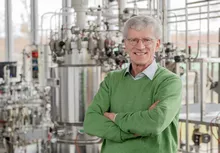Alumni

Technische Universtität München
Lehrstuhl für Klinische Ernährungsmedizin
E-Mail:hans.hauner[at]tum.de

Former Chair of Bioprocess Engineering (until 2021)
Scientific focus
- selective fractionation and concentration of complex raw materials
- structure design in food
- bioprocess and biofunctionality
- analytical techniques for the characterization of food and bio-systems
References
Kulozik UM: “Structuring Dairy Products by Means of Processing and Matrix Design”. In: Food Materials Science – Principles and Practice. Editor: Aguilera JM, Lillford PJ. New York: Springer Science and Business Media, 2008 Abstract
Kulozik UM: “Verfahrenstechnik kontinuierlicher Fermentationen – dargestellt am Beispiel der Milchsäure- und Biomassegewinnung im Rohrfermenter“. Düsseldorf: Verlag des Vereins deutscher Ingenieure (VDI), 1992.Abstract
Kulozik UM: „Einflüsse auf die Permeation von Wasser und gelösten Stoffen sowie auf den Deckschichtabtrag bei der Umkehrosmose“. Düsseldorf: Verlag des Vereins deutscher Ingenieure (VDI), 1986.Abstract

Lehrstuhl für Epidemiologie
Medizinische Fakultät, Universität Augsburg
E-Mail: jakob.linseisen[at]med.uni-augsburg.de
Further information:
Specific expertise in Nutritional Epidemiology; Extensive experience in the planning and conduct of large epidemiological projects, including prospective cohort studies (EPIC-Heidelberg and the German National Cohort study) and cross-sectional studies (Bavarian Food Consumption Survey II); Scientific evaluation of research questions by means of observational ‚real world‘ data in humans; Vice-President of the Scientific Board of the German Nutrition Society.
Dr. Linseisen will contribute to the development of ZIEL by providing his specific expertise for the planning, conduct and scientific use of epidemiologic studies in the context of diet and nutrition (e.g., in the enable project).
Main Research:
- Primary and secondary prevention of chronic diseases
- Health care research, based on patient cohorts and epidemiologic registries
- Experimental studies in high-risk groups and patients
Publications:
Riedl A, (…), Linseisen J. Metabotyping and its application in targeted nutrition: an overview. Br J Nutr. 2017 Jun;117(12):1631-1644. Rohrmann S, (…), Riboli E, Linseisen J. Meat consumption and mortality--results from the European Prospective Investigation into Cancer and Nutrition. BMC Med. 2013 Mar 7;11:63.
Kühn T, (…), Linseisen J. Plasma 25-hydroxyvitamin D and the risk of breast cancer in the European prospective investigation into cancer and nutrition: a nested case-control study. Int J Cancer. 2013 Oct 1;133(7):1689-700.
Jourdan C, (…), Linseisen J. Body fat free mass is associated with the serum metabolite profile in a population-based study. PLoS One. 2012;7(6):e40009.
Hung RJ, (…), Linseisen J, (…), Brennan P. A susceptibility locus for lung cancer maps to nicotinic acetylcholine receptor subunit genes on 15q25. Nature. 2008 Apr 3;452(7187):633-7.
Pischon T, (…), Linseisen J, (…), Riboli E. General and abdominal adiposity and risk of death in Europe. N Engl J Med. 2008 Nov 13;359(20):2105-20.

Former Chair of Microbial Ecology (until 2021)
Director of ZIEL 2003-2014
Scientific focus
- Microbioal ecology
- Food safety research on the ecology of food borne pathogens, e.g. Escherichia coli (EHEC)
- Taxonomy and evolution: biodiversity of food borne microorganisms with focus on raw milk
References
link to full list
Landstorfer R, Simon S, Schober S, Keim D, Scherer S, Neuhaus K (2014) Comparison of strand-specific transcriptomes of enterohemorrhagic Escherichia coli O157:H7 EDL933 (EHEC) under eleven different environmental conditions including radish sprouts and cattle feces. BMC Genomics 15:353, DOI: 10.1186/1471-2164-15-353
von Neubeck M, Baur C, Krewinkel M, Stoeckel M, Kranz B, Stressler T, Fischer L, Hinrichs J, Scherer S, Wenning M (2015) Biodiversity of refrigerated raw milk microbiota and their enzymatic spoilage potential. Int J Food Microbiol 211:57-65
Neuhaus K, Landstorfer R, Simon S, Schober S, Wright P, Smith C, Backofen R, Wecko R, Keim D, Scherer S (2017) Differentiation of ncRNAs from small mRNAs in Escherichia coli O157:H7 EDL933 (EHEC) by combined RNAseq and RIBOseq – ryhB encodes the regulatory RNA RyhB and a peptide, RyhP. BMC Genomics 8:216 DOI: 10.1186/s12864-017-3586-9

Technische Universität München
Lehrstuhl für Biotechnologie der Nutztiere
TUM School of Life Sciences
Scientific focus
- development of genetically engineered pigs for translational research
- Genetic and epigenetic analysis
- Xenotransplantation
References
Flisikowska, T., Merkl, C., Landmann, T, Eser, S., Rezaei, N., Cui, X., Kurome, M., Zakhartchenko, V., Kessler, B., Wieland, H., Rottmann, O., Schmid, R.M., Schneider, G., Kind, A., Wolf, E., Saur, D. and Schnieke, A. (2012). A porcine model of familial adenomatous polyposis. Gastroenterology 143, 1173-1175.
Saalfrank, A., Janssen, K-P., Ravon, M., Flisikowski, K., Eser, S., Steiger, K., Flisikowska, T., Müller-Fliedner, P., Schulze, E., Brönner, C., Gnann, A., Kappe, E., Böhm, B., Schade, B., Certa, U., Saur, D., Esposito, I., Kind, A. and Schnieke. A. (2016). A porcine model of osteosarcoma. Oncogenesis 5, e210. doi: 10.1038/oncsis.2016.19.
Fischer, K., Kraner-Scheiber, S., Petersen, B., Rieblinger, B., Buermann, A., Flisikowska, T., Flisikowski, K., Christan, S., Edlinger, M., Baars, W., Kurome, M., Zakhartchenko, V., Kessler, B., Plotzki, E., Szczerbal, I., Switonski, M., Denner, J., Wolf, E., Schwinzer, R., Niemann, H., Kind A. and Schnieke A. (2016). Efficient production of multi-modified pigs for xenotransplantation by 'combineering', gene stacking and gene editing. Nature Scientific Reports 6, 29081 doi: 10.1038/srep29081.

Technische Universität München
Lehrstuhl für Nutritional Systems Biology
TUM School of Life Sciences
ZIEL - Institute for Food & Health
Leibniz Institute for Food Systems Biology
at the Technical University of Munich
Universität Wien
Fakultät für Chemie
E-Mail: v.somoza.leibniz-lsb[at]tum.de
Further information:
Our research aim is to improve our understanding of food constituents that determine the sensory quality and have an impact on body functions by applying an interdisciplinary Food Systems Biology approach. New solutions for complex questions in food research are achieved by combining food chemistry, molecular biology and bioinformatics, e.g. machine learning, network modeling and molecular analyses. Specifically, we are interested in the molecular sensory characterization of foods along the value chain, their metabolization upon digestion and absorption, and their impact on chemoreceptor-associated human biology with functional consequences affecting, e.g., food intake, and their prediction. In particular, our research aims at explaining the molecular mechanisms of chemoreceptors sensing odor, taste and chemesthetically-active food constituents on a cellular and systemic level by, e.g. CRISPR-Cas9 tailored cell lines and proof-of-concept human intervention trials. As a member of ZIEL, we provide our expertise in the field of bioactives-oriented food research. Additionally, we offer infrastructures within cooperation projects. These include, for example, our sensory laboratory, various high-performance analytical technologies and scientific databases (www.leibniz-lsb.de). Conversely, we benefit from the expertise of ZIEL, e.g. in the field of microbiome research or the ZIEL Core Facility for Human Studies. Our overall aim is to use the synergies available in the research network to explore complex, interdisciplinary issues in the field of "Food - Nutrition - Health", to broaden knowledge and to strength knowledge as well as to promote excellent young scientists.
Publications:
Bitter sensing TAS2R50 mediates the trans-resveratrol-induced anti-inflammatory effect on interleukin 6 release in HGF-1 Cells in culture. Tiroch J, Sterneder S, Di Pizio A, Lieder B, Hoelz K, Holik AK, Pignitter M, Behrens M, Somoza M, Ley JP, Somoza V. J Agric Food Chem. 2021, DOI: 10.1021/acs.jafc.0c07058.
Sweet taste antagonist lactisole administered in combination with sucrose, but not glucose, increases energy intake and decreases peripheral serotonin in male subjects. Schweiger K, Grüneis V, Treml J, Galassi C, Karl CM, Ley JP, Krammer GE, Lieder B, Somoza V. Nutrients. 2020, 12(10):3133. DOI: 10.3390/nu12103133.
Caffeine induces gastric acid secretion via bitter taste signaling in gastric parietal cells.
Liszt KI, Ley JP, Lieder B, Behrens M, Stöger V, Reiner A, Hochkogler CM, Köck E, Marchiori A, Hans J, Widder S, Krammer G, Sanger GJ, Somoza MM, Meyerhof W, Somoza V. Proc Natl Acad Sci U S A. 2017, 114(30):E6260-E6269. DOI: 10.1073/pnas.1703728114.

Former Chair of intestinal Microbiome
current affiliation:
University of Birmingham
Chair of Microbiome Research
Institute of Microbiology and Infection
e-mail: l.hall.3@bham.ac.uk
Further information:
The Hall lab comprises a multi-disciplinary team that is seeking to understand the molecular aspects of microbiome interactions, at the interface of the gut mucosa. We have a particular focus on the early life developmental window, as pregnancy and infancy, and the microbes that colonise during this time (e.g. Bifidobacterium), coincides with key physiological programming, and is when the foundations of future health and wellbeing are laid down.
My labs research programme is organised into three complimentary themes (i) microbe-diet interactions, (ii) colonisation resistance, and (iii) microbiota-host crosstalk. These themes are interlinked by large longitudinal cohort studies, including a preterm infant cohort and a mother-infant dyad cohort. Our clinical studies (and clinical studies lead by other ZIEL members) underpin our wider research activities, which comprise a series of coordinated investigations addressing the mechanistic foundation of microbiome-host interactions in health and disease, with the aim of intervention and therapy development. We collaborate with other ZIEL members to leverage their significant expertise in different disciplines and their innovative model systems.
The lab utilises multi-disciplinary approaches and ZIEL core facilities to answer these key questions including; microbiology (in vitro model-colon systems for complex culturing, molecular microbiology, cultureomics), metabolomics (NMR, M/S), next generation sequencing (RNASeq, 16S rRNA, WGS, metagenomics; both host and microbe), bioinformatics tools, in vivo models (germ-free and infection models) and human studies (infants and adults).
Ehemalige Nachwuchsgruppen

Former Research Group Lipid Metabolism
current affiliation:
University of Regensburg
Functional Lipidomics and Metabolic Research
josef.ecker[at]ukr.de
Research:
Nature provides an enormous diversity of lipid molecules that originate from various pathways. Fatty acids are key modules for various lipids, including cell membrane lipids such as phospholipids or triacylglycerols, which are the major components of lipid droplets. Excess lipids or defects in lipid metabolism are associated with diseases such as metabolic syndrome. Lipids are either obtained from exogenous sources, i.e., diet, or from endogenous biosynthesis. Numerous cellular processes such as cell growth or differentiation relay on de novo synthesis of lipids primarily for cell membrane generation.
The research group “Lipid Metabolism” focuses on investigations of fatty acid and phospholipid biosynthesis. Kinetics and dynamics of lipid metabolic processes are of particular interest as well influencing factors including the gut microbiota and pathophysiological conditions. The independent research group is headed by the principal investigator Josef Ecker with expertise in mass spectrometry, molecular biology, mouse experiments and lipid metabolism.
Recent investigations of our work are summarized in the following article.
You can find a list of our publications here.

Microbial Bioinformatics
Dr. Ilias Lagkouvardos
University of Crete
School of Sciences
71003, Heraklion, Crete, Greece
Research:
Dr. Ilias Lagkouvardos is a microbial ecologist and data integration enthusiast who utilizes bioinformatic methods and tools to address questions related to microbial diversity and ecology in various environments. The primary focus of his research group is the elucidation of the role of distinct microbial compositions in human health and disease by means of sequencing of the versatile 16S rRNA gene. In addition, he explores microbial genomics and metagenomics sequences for insights into the functionality and dynamics of complex microbial communities.
One main line of research in the Lagkouvardos group is to utilize state-of-the-art methods and tools to build specialized analytical pipelines and thereby develop user-friendly bioinformatic solutions for public use. One example of such novel bioifnormatic tool is the IMNGS platform (www.imngs.org), a web database that automatically retrieves all publically available 16S rRNA gene amplicon sequences and processes them in a uniform and organized way. The group also released Rhea, a set of R scripts for the analysis of microbial profiles (lagkouvardos.github.io/Rhea/). Courses disseminating expert knowledge on sequence analysis and demonstrating the usability of these tools are organized regularly.
Selected publications:
- Lagkouvardos I, Fischer S, K¬umar N, and Clavel T. 2017. Rhea: a transparent and modular R pipeline for microbial profiling based on 16S rRNA gene amplicons. PeerJ 5:e2836.
- Lagkouvardos I, Joseph D, Kapfhammer M, Giritli S, Horn M, Haller D, and Clavel T. 2016. IMNGS: A comprehensive open resource of processed 16S rRNA microbial profiles for ecology and diversity studies. Sci Rep 6:33721.
- Lagkouvardos I, Pukall R, Abt B, Foesel BU, Meier-Kolthoff JP, Kumar N, Bresciani A, Martinez I, Just S, Ziegler C, Brugiroux S, Garzetti D, Wenning M, Bui TP, Wang J, Hugenholtz F, Plugge CM, Peterson DA, Hornef MW, Baines JF, Smidt H, Walter J, Kristiansen K, Nielsen HB, Haller D, Overmann J, Stecher B, and Clavel T. 2016. The Mouse Intestinal Bacterial Collection (miBC) provides host-specific insight into cultured diversity and functional potential of the gut microbiota. Nat Microbiol 1:16131.
- Lagkouvardos I, Klaring K, Heinzmann SS, Platz S, Scholz B, Engel KH, Schmitt-Kopplin P, Haller D, Rohn S, Skurk T, and Clavel T. 2015. Gut metabolites and bacterial community networks during a pilot intervention study with flaxseeds in healthy adult men. Mol Nutr Food Res 59:1614-1628.
- Lagkouvardos I, Weinmaier T, Lauro FM, Cavicchioli R, Rattei T, and Horn M. 2014. Integrating metagenomic and amplicon databases to resolve the phylogenetic and ecological diversity of the Chlamydiae. ISME J 8:115-125.
Former Research Group Chronobiology
current affiliation:
Dr. Silke Kiessling
Lecturer in Chronobiology
School of Biosciences,
University of Surrey, UK
s.kiessling(at)surrey.ac.uk
Project @ ZIEL:
Circadian control of microbial function in chronic intestinal inflammation
Disruption of intrinsic clocks, e.g. by mismatch of the external and internal daytime in shift worker, as well as microbiota dysbiosis promote the development of gastrointestinal diseases. This project examines whether the circadian clock controls daytime-dependent fluctuations of microbiota composition and function. Microbiota transfer from will test whether the loss of microbiota fluctuations plays a key role in the development of IBD. Enhancing the clock in an IBD-relevant mouse model will determine whether the circadian clock can be a target for future strategies to treat shift-work associated syndromes.

Former Research Functional Microbiome
current affiliation:
Prof. Dr. Thomas Clavel
Research Group Functional Microbiome
Institute of Medical Microbiology,
RWTH University Hospital, Aachen
Phone: +49 241 80-85523
tclaveluk[at]aachen.de